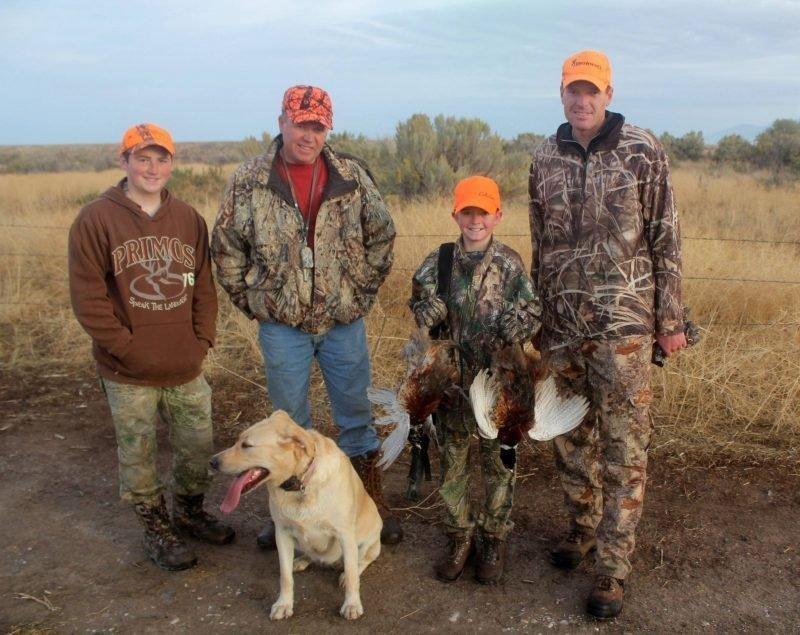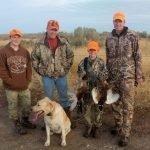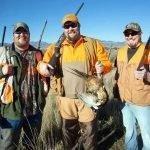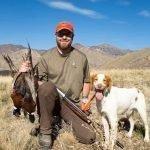Utah Wildlife News Press Release
Utah’s 2018 pheasant hunt runs Nov. 3 – Dec. 2
A rooster pheasant busting out of cover can send your heart racing. The powerful slap of its wings and the loud, excited call the bird makes can scramble your senses, making it difficult to shoulder your gun before the bird flies out of range.
If you gather your senses and make a good shot, though, you’ll bring home one of Utah’s most colorful birds. And, while its meat is slightly tougher than a farm-raised chicken, it actually has more flavor.
Jason Robinson, upland game coordinator for the Division of Wildlife Resources, provides the following tips to help you find pheasants and take a bird this fall. He also encourages you to join Utah’s Upland Game Slam.
How to find birds
If you decide to hunt on private agricultural lands, please remember that you must have written permission from the landowner before hunting on his or her land. And don’t forget about public hunting areas in Utah; pheasants will be released on 61 of these areas before every weekend of the hunt. To learn which areas will receive pheasants, visit https://bit.ly/2PQTcDJ.
The Utah Lake Wetland Preserve in Utah County is also a good place to hunt.
No matter where you’re hunting in Utah, Robinson described what perfect pheasant habitat looks like:
· The center of the area will have a field of wheat or corn that provides the birds with food. The wheat or corn field will be surrounded by stiff, stemmed grass that provides pheasants with good nesting cover.
· Outside the stemmed grass, you’ll find a strip of sparse grass with lots of forbs mixed in. (Forbs are any herb that is not grass or grass like. Forbs are an important food source for pheasant chicks.)
· On the other side of the sparse grass, you’ll find thick, woody cover, or a wetland with cattails. This cover protects pheasants during the winter.
“The type of habitat I’ve described provides pheasants with everything they need to eat, hide, breed and raise young,” Robinson said. “Even if an area doesn’t have all of these features, it can still hold birds. But the more an area matches this description, the better chance you’ll have of finding birds.”
Hunting tips
Pheasants are excellent at hiding. Hunting with a trained bird dog can often help you find them. “If a pheasant has cover to hide in,” Robinson said, “you can be standing only a foot or two from a bird and not know it’s there. A good bird dog can make a huge difference in finding hidden birds.”
You can still find pheasants without a dog, though. Robinson suggests the following tactics:
· Walk slowly. Take your time.
The biggest mistake many pheasant hunters make is walking too fast. Simply slowing down, and stopping and standing still from time to time, can cause birds to flush. “Pheasants will often hide and wait for you to walk past them,” Robinson said. “Slowing your pace down, and stopping and standing still from time to time, makes birds that are close to you nervous. In many cases, they’ll think you’ve spotted them. That’s when they’ll try to get away by flushing into the air.”
· Driving and blocking.
A group of hunters is needed to execute this maneuver. One or two hunters are quietly placed at the end of a field to “block” any pheasants the remaining hunters (the drivers) push to the blockers. Then, the drivers enter the field on the opposite side from the blockers, and start walking towards the blockers.
Pheasants that are pushed by the drivers will often run to the end of the field, see the blockers and then hold tight until continued pressure from the drivers causes the birds to flush. When this happens, all of the hunters—blockers and drivers—can usually get shots.
“If you’re going to try this tactic,” Robinson said, “it’s absolutely vital that every hunter in the group knows where the other hunters are. It’s also vital that each hunter wears plenty of hunter orange.”
· Walking ditch banks.
This is a good strategy if you’re hunting alone or with a friend.
If you’re hunting with a friend, place your friend on one side of the ditch bank and you on the other. Then, walk together down the bank.
Robinson said it’s important to walk to the very end of the ditch bank, fence row or whatever cover you’re hunting. “Pheasants would much rather run than fly,” he said. “You might be pushing a pheasant ahead of you and not even know it. But once you reach the end of the cover, the pheasant won’t have any other place to hide. At that point, the bird will usually flush.”
Upland Game Slam
If you’d like to add some fun to your hunt, consider participating in Utah’s Upland Game Slam. One of the slams—the Long-tail Limit Slam—will reward you for taking a two pheasant limit in a single day. You can learn more about the Upland Game Slam at www.wildlife.utah.gov/upland-game-slam.html.
This year, the slam is easier than ever to join: you can sign up completely online.
More information
If you have questions about hunting pheasants in Utah, visit the DWR’s pheasant hunting web page at https://bit.ly/2enS2zM. You can also call the nearest Division of Wildlife Resources office or the DWR’s Salt Lake City office at 801-538-4700.
- Pheasant hunting is a great way to spend a fall day with family and friends.
- Pheasant hunting is a great way to spend a fall day with family and friends.
- This fall’s pheasant hunt runs for 30 days on both private and public land in Utah. The hunt opens Nov. 3.






